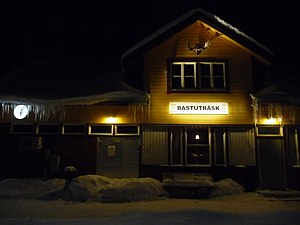Bastuträsk – Skelleftehamn railway line
| Bastuträsk – Skelleftehamn | |||||||||||||||||||||||||||||||||||||||||||||||||||||||||||||||||||||||||||||||||||||||||||||||||||||||||||||||||||||||||||||||||||||||||||||||||||||||||||||||||||||||||||||||||||||||||
|---|---|---|---|---|---|---|---|---|---|---|---|---|---|---|---|---|---|---|---|---|---|---|---|---|---|---|---|---|---|---|---|---|---|---|---|---|---|---|---|---|---|---|---|---|---|---|---|---|---|---|---|---|---|---|---|---|---|---|---|---|---|---|---|---|---|---|---|---|---|---|---|---|---|---|---|---|---|---|---|---|---|---|---|---|---|---|---|---|---|---|---|---|---|---|---|---|---|---|---|---|---|---|---|---|---|---|---|---|---|---|---|---|---|---|---|---|---|---|---|---|---|---|---|---|---|---|---|---|---|---|---|---|---|---|---|---|---|---|---|---|---|---|---|---|---|---|---|---|---|---|---|---|---|---|---|---|---|---|---|---|---|---|---|---|---|---|---|---|---|---|---|---|---|---|---|---|---|---|---|---|---|---|---|---|---|
|
Bastuträsk station at night
| |||||||||||||||||||||||||||||||||||||||||||||||||||||||||||||||||||||||||||||||||||||||||||||||||||||||||||||||||||||||||||||||||||||||||||||||||||||||||||||||||||||||||||||||||||||||||
| Route number : | 124 | ||||||||||||||||||||||||||||||||||||||||||||||||||||||||||||||||||||||||||||||||||||||||||||||||||||||||||||||||||||||||||||||||||||||||||||||||||||||||||||||||||||||||||||||||||||||||
| Route length: | 66 km | ||||||||||||||||||||||||||||||||||||||||||||||||||||||||||||||||||||||||||||||||||||||||||||||||||||||||||||||||||||||||||||||||||||||||||||||||||||||||||||||||||||||||||||||||||||||||
| Gauge : | 1435 mm ( standard gauge ) | ||||||||||||||||||||||||||||||||||||||||||||||||||||||||||||||||||||||||||||||||||||||||||||||||||||||||||||||||||||||||||||||||||||||||||||||||||||||||||||||||||||||||||||||||||||||||
| Power system : | 15 kV 16 2 / 3 Hz ~ | ||||||||||||||||||||||||||||||||||||||||||||||||||||||||||||||||||||||||||||||||||||||||||||||||||||||||||||||||||||||||||||||||||||||||||||||||||||||||||||||||||||||||||||||||||||||||
| Maximum slope : | 17.6 ‰ | ||||||||||||||||||||||||||||||||||||||||||||||||||||||||||||||||||||||||||||||||||||||||||||||||||||||||||||||||||||||||||||||||||||||||||||||||||||||||||||||||||||||||||||||||||||||||
| Top speed: | Bandel 143: (Bastuträsk) –Skelleftehamns övre 100 km / h | ||||||||||||||||||||||||||||||||||||||||||||||||||||||||||||||||||||||||||||||||||||||||||||||||||||||||||||||||||||||||||||||||||||||||||||||||||||||||||||||||||||||||||||||||||||||||
| Operating points and routes | |||||||||||||||||||||||||||||||||||||||||||||||||||||||||||||||||||||||||||||||||||||||||||||||||||||||||||||||||||||||||||||||||||||||||||||||||||||||||||||||||||||||||||||||||||||||||
|
|||||||||||||||||||||||||||||||||||||||||||||||||||||||||||||||||||||||||||||||||||||||||||||||||||||||||||||||||||||||||||||||||||||||||||||||||||||||||||||||||||||||||||||||||||||||||
The Bastuträsk – Skelleftehamn ( Swedish Skelleftebanan ; Finnish Skellefteån rata ) is a Swedish railway line from Bastuträsk to Skelleftehamn in Västerbotten County . It is 66 kilometers long and was built by Statens Järnvägar . The standard gauge line is single-track and electrified. The route is owned by the Swedish state , on whose behalf the route is operated by Trafikverket .
history
The line was built between 1910 and 1914. On December 15, 1910, the Bastuträsk – Klutmark section was opened for temporary freight traffic. This was followed on November 4, 1911, with the start of provisional freight traffic between Klutmark and Kalholmen, and on September 5, 1912, general traffic between Bastuträsk and Kallholmen was started. The Kallholmen – Skelleftehamn section was officially commissioned for freight traffic on July 1, 1914. The two-kilometer extension of the line between Skelleftehamn and Rönnskär was built in 1929 in connection with the construction of the branch line to Boliden.
In the first few years there was not much traffic on the route. This changed when, in 1924, gold-bearing ore was found at Boliden, northwest of Skellefteå. The decision was quickly made to process the ore in a steelworks in Rönnskär at the tip of a headland outside Skelleftehamn. In the first few years, the ore was transported by road from Boliden to various stations along the route. The ore company Bolidenbolaget and Statens Järnväger agreed very quickly to build a 24-kilometer railway line from Boliden to the Bastuträsk – Skelleftehamn line, which was connected to Slind station.
Boliden – Slind railway line
The line was built due to the ore deposits in Boliden. The route was largely financed by SJ, the mining company took care of the transportation. The construction of the route was completed in 1929.
From 1943 the route was used by passenger trains. In 1954 a processing plant was built in Boliden. However, the ore mine was soon exhausted and closed in 1967. Processing continued with ore from other mines. In 1991 the ore trains from Boliden to Rönnskär ended. Transport by road was already cheaper at this point. That is why the Boliden – Slind branch line was no longer used and was dismantled.
Kristineberg – Boliden cable car
Large amounts of copper , silver , gold and less noble products such as arsenic , sulfur and lead were found in racing cars . In 1940 the company began mining ore in Kristineberg . It was discussed to build a railway line there. However, those responsible opted for a cable car from Kristinebergsvägen to Boliden, where the ore was loaded onto the train. The 69-kilometer cable car was in operation between 1943 and 1987 and was long considered the world's longest cable car.
Operation today
During the 1930s and 1940s, passenger transport was switched to multiple units. In 1945 a direct sleeper connection from Stockholm to Skelleftehamn Övre was introduced. The decline in passenger traffic began in the late 1950s when passenger traffic between Skelleftehamn Övre and Rönnskär ceased. Passenger traffic in the direction of Bastuträsk became less and less and was completely discontinued in 1990 after the direct sleeper to Stockholm did not operate in 1987. Scheduled passenger traffic no longer takes place on the route.
After the cessation of passenger traffic, the route was upgraded for freight traffic. The axle load was increased to 25 tons and in 1997 the line was electrified. In the same year, a track triangle was put into operation, with which direct traffic from the south such as from Helsingborg to Skelleftehamn is possible without changing the locomotive and direction.
Most trains run largely on Rc4 or Rd2 locomotives or T44 diesel locomotives , both from Green Cargo and trains carried by Hector Rail . Mainly copper and ore freight trains run on the route.
gallery
Individual evidence
- ↑ JNB 2019 Bilaga 3 E STH per sträcka. (PDF) Utgåva 2018–12–14. trafikverket.se, December 14, 2018, p. 134 , accessed on January 22, 2019 (Swedish).
- ↑ Kjell Byström: after historiskt.nu, Bandel 40. December 5, 2004, accessed on June 13, 2013 (Swedish).
- ^ Lars-Olof Karlsson: Järnvägar i historien. Sveriges Järnvägars historia - databank. March 31, 1996, accessed July 17, 2013 (Swedish).
- ↑ a b c d Bastuträsk-Skellefteå-Skelleftehamn-Rönnskärsverken. In: jarnvag.net. Retrieved January 2, 2016 (Swedish).
- ^ Gunnar Lundström: Transport - Magirusbilar / linbana. Kristineberg, från glesbygd till modernt gruvsamhälle. Retrieved July 19, 2013 .
- ↑ Bastuträsk-Skellefteå-Skelleftehamn-Rönnskärsverken. In: jarnvag.net. Retrieved January 2, 2016 (Swedish).
Web links
- Bastuträsk-Skellefteå-Skelleftehamn-Rönnskärsverken. In: jarnvag.net. Retrieved January 2, 2016 (Swedish).
- Info and pictures on Jvgfoto.se




